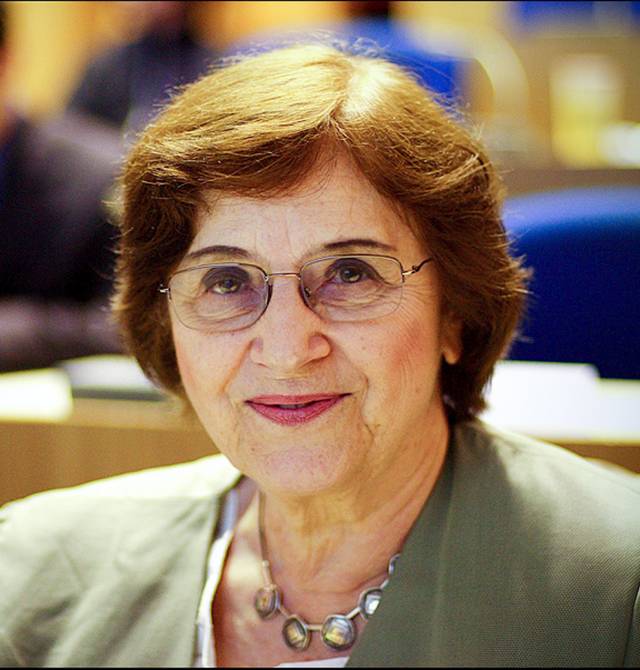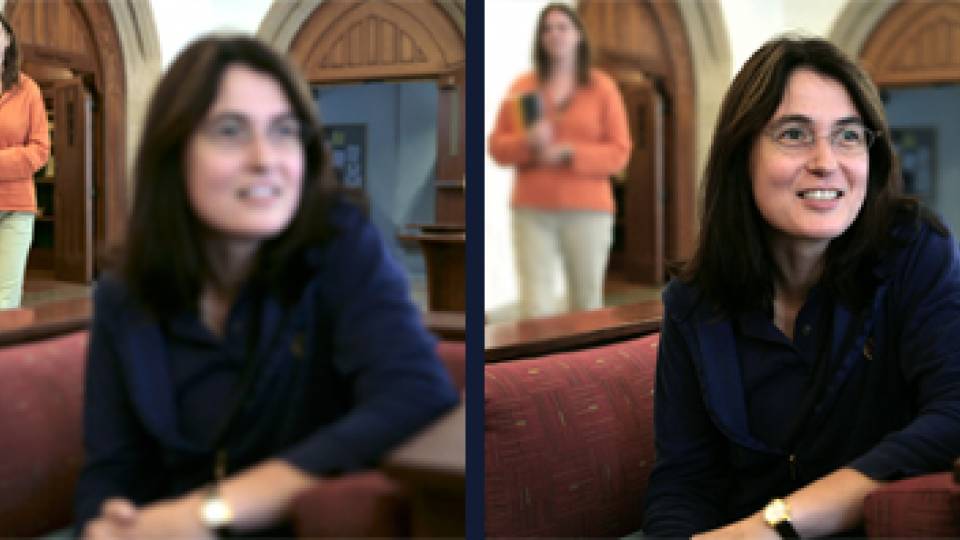
Anne Treisman
Anne Treisman, a Princeton University psychologist who made major contributions to the understanding of attention and perception, died Friday, Feb. 9, in New York City. She was 82.
Treisman explored the mechanisms of attention, first in selective listening and then in visual perception. Her work helped explain how we focus on relevant auditory information in noisy environments and how we extract meaning from complex visual scenes. The concepts she proposed have influenced generations of scientists in cognitive psychology.
Treisman, the James S. McDonnell Distinguished University Professor of Psychology, Emeritus, joined the Princeton faculty in 1993 and transferred to emeritus status in 2010.
In 2013, Treisman received the National Medal of Science, the nation's highest scientific honor.
In 2015, a $10 million gift to Princeton created the Daniel Kahneman and Anne Treisman Center for Behavioral Science and Public Policy. Treisman was married to Kahneman, the Eugene Higgins Professor of Psychology, Emeritus, and a professor of psychology and public affairs, emeritus.
Treisman's work has appeared in numerous book chapters and more than 80 journal articles. Over the decades, her research has helped illuminate new areas of study in cognitive science.
"Psychology has changed enormously in the half century of my career, moving from a rather narrow behaviorism through the cognitive revolution to the interactions of linguistics, philosophy and computer science under the cognitive science umbrella, and now with cognitive neuroscience, linking mind to brain," Treisman wrote in 2014 about her career and life in "The History of Neuroscience in Autobiography, Volume 8."
She added: "Probably the most important changes in my lifetime have been in the degree of interaction between behavioral findings in cognitive tasks and in our understanding of the neuroscience of the brain. The two fields met in the early years mainly in research on the effects of brain lesions on psychological tasks. Now, with the advent of brain imaging, they have essentially fused into one field, cognitive neuroscience."
Sabine Kastner, a professor of psychology and the Princeton Neuroscience Institute who came to Princeton in 2000, said that Treisman "became a very important mentor" who helped bridge research ideas.
"I was trained as a neuroscientist and was hired as one of the first faculty members who did not have formal training and a degree in psychology," Kastner said. "Anne taught me what I needed to learn about the cognitive psychology of attention and behavioral task design. Whenever we had a new idea in my lab for a behavioral experiment, we would stop by Anne’s office and ask for her thoughts. Often, she’d tell us: 'Oh yes, this has been done and was experiment 5 in a paper by X published in 1963.'
"Anne had an extraordinary encyclopedic memory for work done in her field — there will be many unnecessary replications from now on. Later, after she had retired, I met her a couple times in Berkeley, where we both spent our summers. I always had to tell her about the latest findings from the field that we both loved, and she would always ask insightful and challenging questions in the typical gentle and moderate way that characterized her. Anne was a wonderful mentor, colleague and role model, and I will never forget her kindness, warmth and generosity."
"Anne Treisman’s impact on the field of cognitive psychology was immense," said Nancy Kanwisher, who worked with Treisman as a postdoc and is the Walter A. Rosenblith Professor of Cognitive Neuroscience at the McGovern Institute for Brain Research at the Massachusetts Institute of Technology. "She was the source of an astonishing number of the foundational findings and concepts in the field. Though a giant in her field, she was as a person unassuming, gracious and kind. She was beloved and revered by a whole generation of cognitive psychologists whose work she inspired."
Anne Marie Taylor was born Feb. 27, 1935, in Wakefield, Yorkshire, in England. She was interested in science as a child but studied modern and medieval languages at the University of Cambridge. After receiving her bachelor's degree, she was awarded a research fellowship toward a doctoral degree in French literature but quickly realized that she'd rather do a second undergraduate degree — in psychology.
In the mid 1950s the "cognitive revolution" had started, Treisman said, and she went on to pursue a doctorate in psychology at the University of Oxford, which she completed in 1962. Her thesis, "Selective Attention and Speech Perception," led to a position at the Medical Research Council psycholinguistics unit at Oxford. At this time, she was married to Michel Treisman, with whom she had four children.
She recalled taking her first child, Jessica, to work. "I had a soundproof cubicle in my office because of my work on auditory attention, and it was occasionally of help with a fractious baby. ... I continued with research on selective listening, extending and writing up the experiments from my thesis, although my own attention was somewhat divided between work and the babies."
Treisman spent 1966-67 as a visiting research scientist in behavioral sciences at Bell Labs in Murray Hill, New Jersey, where she explored visual attention and the perception of objects. "There was in the air at the time a notion that perception involved the analysis of a number of different features, including shape, color, orientation and motion, which could be separately attended to," she said.
Treisman returned to Oxford for the next decade, and in 1977, after the end of her marriage, went to the Center for Advanced Study in the Behavioral Studies at Stanford University with Kahneman.
In 1978, the couple took faculty positions at the University of British Columbia, where Treisman was a professor of psychology. In 1980, she wrote a paper called "A Feature Integration Theory of Attention," proposing that attention acts as a selective window in the brain, linking disparate features of the same object — such as its color, shape, distance and motion — into an integrated whole.
The theory's concepts have been used by applied psychologists in many ways, from airport baggage inspectors employing its principles to scope out hidden weapons to educators using its tenets to design classrooms that stimulate children without overwhelming them.
"I entered the world of visual attention arguing against Treisman’s Feature Integration Theory," said Jeremy Wolfe, professor of ophthalmology and radiology, Harvard Medical School, and director of the Visual Attention Lab at Brigham and Women's Hospital. "I rapidly discovered that Anne was, at once, the most incisive and most supportive 'opponent' that one could have in a scientific argument. Her influence has shaped my research since the 1980s."
In 1986, Treisman and Kahneman moved to the University of California-Berkeley, where they shared a lab and continued to collaborate, bringing in several graduate students.
In 1991, Treisman and Kahneman went to the Russell Sage Foundation in New York for a year, during which time a fire destroyed their house in Berkeley. The loss played a part in reorienting them, and in 1993 the couple joined Princeton's faculty.
For the next 17 years, Treisman played a central role in the psychology department, including helping develop a program in cognitive neuroscience. The purchase of an MRI machine allowed for new brain imaging research exploring the neural basis of cognition. The University now has the Princeton Neuroscience Institute, bringing together the study of psychological processes and brain activity.
"Anne Treisman played a very important role in the intellectual direction of the psychology department in the decade before she retired,” said Princeton Provost Deborah Prentice, the Alexander Stewart 1886 Professor of Psychology and Public Affairs. "We were doing a lot of hiring in the field of neuroscience, and Anne had a better perspective on how developments in neuroscience were transforming the discipline of psychology than anyone else in the department. Her colleagues respected her judgment and valued her good opinion."
Working with colleagues and students at Princeton, Treisman advanced her research. Most recently, she studied how we perceive a whole picture or scene — how we are capable of distributing attention in order to extract information about what we are seeing when we open our eyes.
"Anne was an inspiration both as a scientist and a person," said Jonathan Cohen, the Robert Bendheim and Lynn Bendheim Thoman Professor in Neuroscience and professor of psychology and the Princeton Neuroscience Institute.
"Her contributions continue to stand as a model for how science progresses at its best, combining deep and insightful challenges to existing theories, experimental evidence in support of those challenges, and creative and productive new ideas about how our thinking should be changed.
"Her personal interactions reflected a similarly remarkable balance of honesty and hard realism with compassion, respect and optimism. Few can hope to achieve what Anne did, but all of us have been improved by aspiring to do so."
"Anne Treisman was one of the most original, influential, clever and dignified, not to mention celebrated, researchers in the cognitive sciences," said Eldar Shafir, the Class of 1987 Professor in Behavioral Science and Public Policy and professor of psychology and public affairs. "She will be sorely missed. It is a privilege for Princeton's Kahneman-Treisman Center for Behavioral Science and Public Policy to celebrate her influence and to honor her memory."
In 2011, neuropsychologist Lynn Robertson, now a professor emerita at Berkeley and a senior medical research scientist with the Veterans Administration, edited "From Perception to Consciousness: Searching with Anne Treisman," with Wolfe — a collection of reprints of Treisman's most influential papers and discussion of her ideas. "The book reflected Anne’s impact and continued relevance across a career that spanned over 50 years," Robertson said. "She was a true giant and I will miss her insightful comments regarding my own work in the neuropsychology of visual-spatial attention."
Tatiana Emmanouil, a former student of Treisman's who is now an assistant professor of psychology at Baruch College, said: "I walked into Anne’s office the very first time inspired by her work and intellectual impact . Soon after, I became aware of the phenomenal presence of Anne herself. She was brilliant, creative and had fun with science. Anne shaped the field of cognitive psychology with her ideas. She was also kind and caring, and it showed through her gestures and delicate smile. Anne changed my life, I loved her like family and I will miss her dearly."
Treisman is survived by her husband, Daniel Kahneman; her children, Jessica, Daniel, Stephen and Deborah; and four granddaughters.
View or share comments on a blog intended to honor Treisman's life and legacy.



